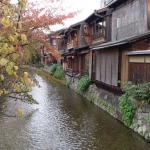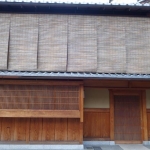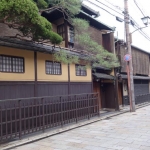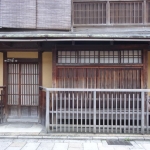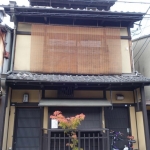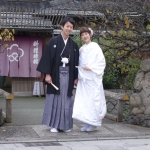Gion Shinbashi
The knell of the bells at the Gion temple
Echoes the impermanence of all things.
The color of the flowers on its double-trunked tree
Reveals the truth that to flourish is to fall.
He who is proud is not so for long,
Like a passing dream on a night in spring.
He who is brave is finally destroyed,
To be no more than dust before the wind.
–Heike Monogatari
Red: Places of Interest Blue: Eat Green: Sleep
Kyoto’s most famous geiko district is located around Shijo Avenue between Yasaka Shrine in the east and the Kamo River in the west. It is filled with shops, restaurants and o-chaya (teahouses), where geiko (Kyoto dialect for geisha) and maiko (geiko apprentices) entertain.
The Geiko or Geisha of this district are credited with preserving this area.
Courtesan culture arose in the early Edo period (1600–1868). At this time, laws were passed restricting brothels to pleasure quarters (yūkaku) which were walled districts set some distance from the city center. Although there were many such quarters, the three with the most lasting prominence were the Shimabara in Kyoto, the Shinmachi in Osaka, and in Edo (present-day Tokyo), the Yoshiwara. These rapidly grew into large, self-contained neighborhoods offering all manner of entertainment, including fine dining, free performances, and frequent festivals and parades.
No stranger gains admittance to an o-chaya in Gion; no amount of money takes the place of a formal introduction by a trusted regular.
The geiko of Gion are not prostitutes. They are performers, entertainers, as the character gei in geiko implies. As such, they are responsible to this day for keeping many of the traditional performing arts alive in modern Japan.
This area is a popular place for wedding pictures.
With sudare blinds covering the upstairs levels, this famous traditional area remains forever intriguing.
http://www.gpsmycity.com/gps-tour-guides/kyoto-1958.html
Walking Tour at Night: http://www.waraido.com/walking/gion.html
Hanami-koji
A couple of blocks further east of Chugen-ji Temple, Hanami-koji or “blossom viewing lane” runs north to south across Shijo. This is Gion’s most famous street. South of Shijo it is beautifully preserved and broadens out into a broad flagstone paved strolling area bordered on both sides by traditional teahouses called o-chaya. On the southeast corner of Shijo and Hanami-koji is a huge red-walled teahouse called Ichiriki Chaya.
Tatsumi Daimyōjin Shrine
This local shrine is frequented by neighborhood geiko on Shimbashi.
Gion Corner
If you walk straight down Hanami-koji south from the Ichiriki Chaya you reach the Gion Kobu Kaburenjo theater, also known as Gion Corner.
Here in April and October the geisha of this district give their famous Miyako Odori dance performance. Throughout the year, tourists can also enjoy an hour long evening digest of traditional culture, with tea ceremony, flower arrangement, geisha dances and classical Japanese music. Check the Gion Corner website for details.
Gion Sweets
Gion is also famous for its sweets and no trip here would be complete without trying some. Back on Hanami-koji is a popular cake shop, Patisserie Gion Sakai. This shop is just a short walk south of Shijo on the west side of Hanami-koji and easy to spot because though built in a traditional style, the wood is very new.
Tsujiri
The most famous sweet shop in Gion is Tsujiri.
Isamu Yoshii
On November 8, a ceremony is performed to honor the poet and playwright Isamu Yoshii (1886-1960), who was a much-loved patron of Gion. Just near to the Tatsumi Bridge that crosses the Shirokawa River in Gion, the maiko and geiko from this area offer white chrysanthemums at a stone monument that has a poem by Isamu engraved on it, and later there is a reception where matcha and soba are served. This natural stone monument was erected to celebrate Yoshii Isamu’s 70th birthday on the 8th of November, 1955. The name of the ceremony “Kanikakuni” translates as “no matter what happens” and comes from the first line of Isamu’s poem that is carved into the rock:
No matter what happens
I yearn for Gion
Even when I sleep
The sound of water
Flows beneath my pillow
Gion Antiques and Crafts
Follow Yamato-Oji Street north, cross Shijo, and keep going. North of Shijo, Yamato-Oji’s name changes to Nawate-dori Street. On this street and on Shinmonzen and Furumonzen (two streets that run off Nawate to the east) you can find Gion’s best traditional craft and antique shops. This is a great area to ramble in and browse, with shops selling textiles, scrolls, prints, and furniture. Many of the businesses are housed in traditional wooden townhouses and have been in the same family for generations.
Josho-ji Temple
Josho-ji is a Nichiren sect Buddhist temple in north west Kyoto.
Josho-ji was founded in 1616 in the early part of the Edo Period by Jakushoin Nichiken Shonin.
The temple had many more buildings than can be seen today and was home to several hundred scholar monks.
Josho-ji is associated with the Edo Period courtesan, Yoshino Tayu II, who was famed for her beauty and grace. According to the stories, she either eloped with her lover, the merchant Haiya Joeki (also spelled Haiya Shoeki), or he paid for her to be released from her Shimabara tea house. A devout follower of Nichiren Buddhism, Yoshino Tayu is said to have helped finance the beautiful, once vermillion gate at the entrance to the temple, known as Yoshino-mon in her honor.
Yoshino Tayu died at the young age of only 38 and her grave, marked by a tall, stone pillar, is in the temple along with that of her partner Haiya Joeki.
Josho-ji Temple holds a memorial service for Yoshino Tayu on the second Sunday in April every year. This consists of a procession of tayu (of which there are only a handful left in Kyoto now) adorned in gorgeous kimono, followed by an open-air tea ceremony performed by the tayu and a flower arranging (ikebana) exhibition staged within the temple grounds.
Nowadays, visitors can view a video on the life of Yoshino Tayu and for an extra charge enjoy a matcha green tea and traditional sweet in the temple.
Josho-ji Temple is well-known for its lovely garden which is particularly popular during the autumn leaf viewing season in Kyoto and for its cherry blossoms as is nearby Genko-an.
Festival in commemoration of Yoshino Tayu, considered to be one of the most famous female entertainers in the 17th century. If it rains, the procession will be canceled.
Schedule & Key Events:
10:20 a.m.-10:50 a.m. Procession of tayu (female entertainers) from in front of Genko-an Temple to Josho-ji Temple


